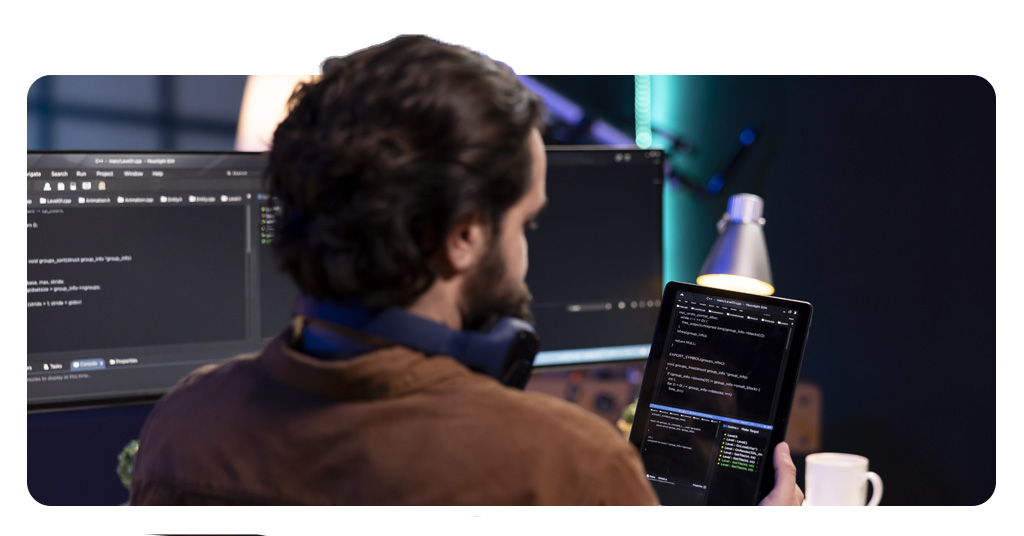Building apps no longer demands a background in coding or tech. With no-code development, more people can bring digital ideas to life using simple, visual tools and logic.
Templates and automation shortcuts are changing how projects get built. Whether for a side hustle or a serious startup, the possibilities grow without typing a single line of code.
This guide by Insiderbits was created to unpack what’s possible without programming. Keep reading to compare platforms, uncover trends, and see where no-code might take you.
Related: Master Programming: Essential Python Apps for Beginners

What is No-Code Development and How Does It Work?
Creating apps used to mean learning complex languages and hiring developers. Now, visual platforms let users build real software using drag-and-drop blocks and simple logic controls.
These platforms turn technical building into something more intuitive. You don’t need to understand JavaScript or databases to craft apps that perform real tasks across web or mobile.
No-code development translates your visual inputs into functional code, automating the programming process so you can focus on structure, purpose, and design instead of syntax.
The Rise of Visual App Builders
Digital builders are shifting from traditional coding to visual assembly lines. You can connect components, assign actions, and shape workflows using clean interfaces with feedback loops.
These platforms borrow ideas from builders, evolving them into powerful tools for full software. What once felt limited now supports data management, automation, and real-time updates.
Thanks to this shift, no-code development platforms have matured into environments where ideas move faster. The tools speak in logic, making software creation more approachable.
Who Benefits Most from No-Code Tools Today?
Entrepreneurs looking to launch apps without developers turn to no-code builders to test ideas, gather feedback, and improve products without draining their budgets or waiting on sprints.
Small businesses use these tools to create booking systems, internal dashboards, or customer apps tailored to their operations. It’s about speed and control without external dependencies.
As operation teams discover these platforms, no-code development becomes a go-to solution for turning concepts into interactive products without hiring a full development team.
Getting Started with No-Code Development: Tips for Beginners
Starting with app creation doesn’t mean diving into deep tech. With the right platform, clear goals, and curiosity, building digital tools can feel surprisingly approachable and fun.
Instead of jumping into dozens of features, beginners should focus on learning core functions, playing with templates, and experimenting with real use cases to build confidence.
Choosing Your First No-Code Platform Wisely
Each platform has its strengths. Some prioritize mobile apps, others focus on databases or websites. Picking one that matches your goal saves time and frustration early on.
Look for clean interfaces, useful templates, and active communities. Good documentation also matters. The right platform doesn’t overwhelm and encourages you to build right away.
Common Mistakes to Avoid When Starting Out
Jumping into advanced builds too quickly is a common trap. Start small. Learn what each function does and test often so you can fix things before scaling.
While excitement is great, using no-code development as a shortcut without understanding logic and flow often backfires. Take time to understand how platforms think and connect their pieces.
What You Can (and Can’t) Build as a Beginner
Simple apps like task trackers, event check-ins, or landing pages are a great place to start. These require minimal setup and help beginners understand structure and interaction.
More complex ideas involving custom integrations or unique behaviors might stretch platform limits. No-code helps speed things up, but some ideas still need custom code or hybrid support.
Related: Best AI for Programmers: Code Smarter, Faster & Better
Best No-Code Platforms to Build an App Without Coding
App creation has evolved into a more visual process, and plenty of platforms now make it possible to build real tools using clicks instead of code.
Each platform has its own strengths, depending on what kind of app you want to create. Some focus on simplicity, others offer deeper customization and business-ready features.
Adalo
| Pricing: | Free, with subscription plans starting at $45 per month. |
| Available For: | Web. |
Adalo makes app creation feel approachable. Its interface bridges no-code development with design, allowing users to build interactive screens and connect real app functions easily.
You can publish directly to iOS and Android, add forms, connect databases, and create user flows with clicks. It’s a solid choice for simple business apps and prototypes.
While powerful for mobile apps, Adalo can feel limiting when scaling. Complex logic or deep customization require workarounds or switching to platforms with broader development support.
Adalo’s Best Features
- Visual Interface with Real-Time Preview: Adalo lets users build screens and connect actions using drag-and-drop tools, previewing changes instantly without switching;
- Direct Publishing to App Stores: users can launch apps directly to iOS and Android, skipping complex setups and focusing on getting their ideas into real users’ hands;
- Built-In Database and Logic Tools: Adalo supports custom user data and dynamic content, offering a practical foundation for no-code development across app types.
Bubble
| Pricing: | Free, with subscription plans starting at $32 per month. |
| Available For: | Web. |
Bubble is built for those who want control without writing code. Its editor gives freedom to design, structure, and test powerful web apps in one place.
The platform stands out for flexibility, allowing full control over workflows, APIs, and database logic. Apps built with Bubble can scale, support user logins, and connect with external tools.
Advanced features like dynamic data, condition-based actions, and responsive design make Bubble a strong choice for those ready to level up their no-code development.
Bubble’s Best Features
- Full Control Over Workflows: Bubble lets users design custom workflows step by step, connecting actions, conditions, and data to create apps that respond as intended;
- Responsive Design Tools: users can create layouts that adjust across devices, using visual breakpoints and flexible elements to ensure apps look great on phones;
- Backend Integration Capabilities: Bubble connects to external APIs and supports custom database structures, offering advanced tools for no-code development.
Glide
| Pricing: | Free, with subscription plans starting at $60 per month. |
| Available For: | Web. |
Glide turns spreadsheets into functional apps using a visual builder. It’s ideal for creating lightweight tools like trackers, forms, and portals without touching a single code editor.
By syncing with Google Sheets or Airtable, updates reflect instantly inside your app. The interface is straightforward, making layout adjustments and data connections easy to manage.
AI tools and automation features give Glide a modern edge, allowing faster builds and smarter functionality—perfect for those stepping into the world of no-code development.
Glide’s Best Features
- Spreadsheet-Driven Logic: Glide connects to Google Sheets or Airtable, turning data into apps with interactive features, real-time syncing, and easy updates;
- Fast Prototyping with Templates: choose from hundreds of pre-built templates to create apps like CRMs, directories, or forms in just a few clicks;
- AI Tools and Automation Features: Glide enhances functionality with smart actions and AI-powered tools, expanding what’s possible in the world of no-code development.
Customization and Flexibility: Which Platform Wins?
Bubble takes the lead when it comes to customization and flexibility. It allows full control over design, workflows, and data, making it ideal for more complex applications.
Adalo is easier to use and great for polished mobile apps, but it can feel restrictive when trying to scale or add custom logic beyond what’s built-in.
Glide excels in speed, but limits advanced customization. For those prioritizing power and freedom, Bubble clearly offers the strongest toolkit in no-code development.
No-Code vs. Traditional Development: Pros and Cons
Building digital tools no longer requires deep coding knowledge, but traditional development still holds advantages depending on the app’s scope, complexity, and long-term goals.
Choosing between these paths depends on your priorities. Speed, budget, customization, and future maintenance all play a role in deciding which method suits your project best.
Speed, Cost, Control: Where No-Code Shines
Launching an app with visual tools can take days instead of months. Drag-and-drop builders, templates, and ready-made logic eliminate much of the traditional waiting game.
Lower costs also attract businesses and solo creators. Without hiring developers or managing servers, teams can quickly launch MVPs or internal tools with a fraction of the investment.
The Customization Trade-Off: Power vs. Simplicity
Traditional development allows endless customization, letting teams fine-tune everything. With no-code, there’s a balance between accessibility and how much control you’re able to retain.
While simple builds work great, no-code development can fall short when handling custom components, heavy data processing, or specialized integrations across complex systems.
When You Should Still Call a Developer
Some projects need fine-tuned performance, deep API work, or security features that visual tools don’t fully support. In these cases, hiring a developer is still essential.
Apps that involve unique user permissions, complex animations, or deep back-end control often demand custom solutions that go beyond visual platforms and their built-in features.
Related: Coding on the Go: Best Mobile Apps to Learn Programming in 2025
How Businesses Are Using No-Code to Innovate
Teams are building internal dashboards, customer portals, and operational tools faster now. No-code platforms allow quicker changes, better feedback loops, and lower development costs.
Innovation doesn’t wait for perfect code. Businesses now test new ideas faster and iterate continuously, using visual platforms to adapt in real-time to market needs or customer input.
How No-Code Fosters Rapid Experimentation and Scaling
Companies of all sizes are using no-code development to test product ideas without large budgets. This flexibility allows them to shift direction quickly without slowing down operations.
Early-stage startups benefit most, building MVPs fast and collecting real feedback before scaling. Larger organizations also experiment with new tools before committing to full cycles.
AI-Powered Builders and Smart Suggestions
Modern platforms now include AI that generates layouts, suggests workflows, and connects data. These features reduce guesswork and make app creation feel more intuitive and efficient.
These smart additions don’t just speed up development. They also help users uncover new ways to solve problems and push the boundaries of what’s possible without traditional code.
Workflow Automation and API Integrations on the Rise
No-code tools are connecting with services like Stripe, Airtable, and Zapier, letting businesses automate daily tasks and centralize data without building everything from scratch.
Some platforms prioritize deeper integrations, helping companies manage operations in one place. These powerful add-ons make no-code development more scalable and enterprise-ready.
The Future of App Building Is Already Here
Apps can now be built without code, using visual tools that simplify the process without limiting what’s possible. Creation is shifting, and more people are jumping in.
Insiderbits crafted this guide to show how no-code development helps bold ideas become real products. It’s a space where thinking big doesn’t require learning a programming language.
Keep exploring our website! Insiderbits is packed with practical tools, sharp insights, and guides that help turn bold thinking into real outcomes without unnecessary complexity or delays.





